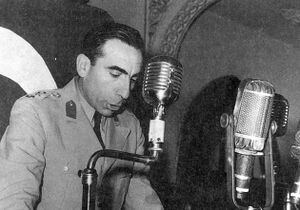1960 Turkish coup d'état
 Staff Colonel Alparslan Türkeş reading the coup declaration on the radio (Friday, May 27, 1960 at 5.25 am) | |
| Interests | Alparslan Türkeş |
|---|---|
| Description | Coup led by the Turkish section of the stay-behind Gladio network |
The 1960 Turkish coup d'état was the first coup d'état in the Republic of Turkey. The coup was staged by a group of 38[1] young Turkish military officers, acting outside the Staff Chiefs' chain of command. It was orchestrated by Alparslan Türkeş and ultimately led on May 27, 1960, by General Cemal Gürsel,[2] against the democratically elected government of the Democrat Party.
Colonel Alparslan Türkeş orchestrated the plot. He was a member of the junta (National Unity Committee) and had been among the first 16 officers trained by the United States in 1948 to form a stay-behind counter-guerrilla.
Background
The incident took place at a time of both socio-political turmoil and economic hardship, as US aid from the Truman doctrine and the Marshall Plan was running out and so Prime Minister Adnan Menderes planned to visit Moscow in the hope of establishing alternative lines of credit.[3][4][5]
Coup
Colonel Alparslan Türkeş orchestrated the plot. He was a member of the junta (National Unity Committee) and had been among the first 16 officers trained by the United States in 1948 to form a stay-behind counter-guerrilla. As such, he explicitly stated his anticommunism and his faith and allegiance to NATO and CENTO in his short address to nation, but he remained vague on the reasons of the coup. On the morning of May 27, Türkeş declared the coup over radio, which ultimately announced "the end of one period in Turkish history, and usher in a new one":
The Great Turkish Nation: Starting at 3:00 am on the 27th of May, the Turkish armed forces have taken over administration throughout the entire country. This operation, thanks to the close cooperation of all our citizens and security forces, has succeeded without loss of life. Until further notice, a curfew has been imposed, exempt only to members of the armed forces. We request our citizens to facilitate the duty of our armed forces, and assist in reestablishing the nationally desired democratic regime.[6]
In a press conference on the following day, Cemal Gürsel emphasized that the "purpose and the aim of the coup is to bring the country with all speed to a fair, clean and solid democracy.... I want to transfer power and the administration of the nation to the free choice of the people"[7]
Purge
The junta forced 235 generals and more than 3,000 other commissioned officers into retirement; purged more than 500 judges and public prosecutors and 1400 university faculty members and put the chief of the General Staff, the president, the prime minister and other members of the administration under arrest.[8][9] It followed by the appointment of the commander of the army General Cemal Gürsel, as the provisional head of state, prime minister and the minister of defense.
Yassıada trials
The minister of the interior committed suicide while he was detained in the Turkish Military Academy.
President Celal Bayar, prime minister Adnan Menderes and several other members of the administration were put on trial before a court appointed by the junta on the island Yassıada in the Sea of Marmara. The politicians were charged with high treason, misuse of public funds and abrogation of the constitution.
The tribunals ended with the execution of Adnan Menderes, Minister of Foreign Affairs Fatin Rüştü Zorlu and Minister of Finance Hasan Polatkan on İmralı island on 16 September 1961.
Aftermath
A Constitutional referendum was held on 9 July 1961. A new constitution was drawn up to replace the one from 1924. It was approved by 61.7% of voters, with an 81.0% turnout.[10]
A month after the execution of Menderes and other members of the Turkish government, general elections were held on 15 October 1961. The administrative authority was returned to civilians, but the military continued to dominate the political scene until October 1965.[7] General İsmet İnönü held the office of Prime Minister for the third time from 1961 to 1965. Turkish Army Colonel Talat Aydemir organised two failed coups d'état in February 1962 and May 1963. In the first free elections after the coup, in 1965, Süleyman Demirel was elected and held the office until 1971, when he was removed by another coup.
Turkey was haunted by the economic legacy of this coup for many decades: "Where are we now and where are countries like Portugal, Greece and Spain, with which we have moved away in the competition for development in the 1960s? While we hover around an income of $ 5,000 per capita, they have been at $ 20,000 for several years. In short, a mess."(Hasan Cemal, Milliyet, October 2006[11])
References
- ↑ http://www.mitpressjournals.org/doi/abs/10.1162/JCWS_a_00550#.VyP-SjArLIU
- ↑ http://www.allaboutturkey.com/darbe.htm
- ↑ Çavdar, Tevfik (1996). "Birinci Bölüm". Türkiye'nin Demokrasi Tarihi 1950-1995 (in Turkish) (2nd ed.).
- ↑ https://web.archive.org/web/20130901223303/http://www.zaman.com.tr/dunya_darbe-olmasaydi-menderes-moskovaya-gidecekti_693501.html
- ↑ http://www.haberturk.com/blog/bedia-ceylan-guzelce/745922-menderesi-nato-astirdi
- ↑ Dilipak, Abdurrahman (1991). Ihtilaller Donemi. Istanbul: Dogan Ofset. p. 70.
- ↑ a b http://www.allaboutturkey.com/darbe.htm
- ↑ https://web.archive.org/web/20131109105311/http://www.zaman.com.tr/full-name/27-mayisin-hesabi_988554.html
- ↑ https://web.archive.org/web/20131109105352/http://www.zaman.com.tr/_cunta-en-buyuk-tasfiyeyi-yargida-ve-orduda-yapti_989947.html
- ↑ Dieter Nohlen, Florian Grotz & Christof Hartmann (2001) Elections in Asia: A data handbook, Volume I, p254 ISBN 0-19-924958-X
- ↑ https://web.archive.org/web/20120320213628/http://www.time.com/time/magazine/article/0,9171,895700,00.html